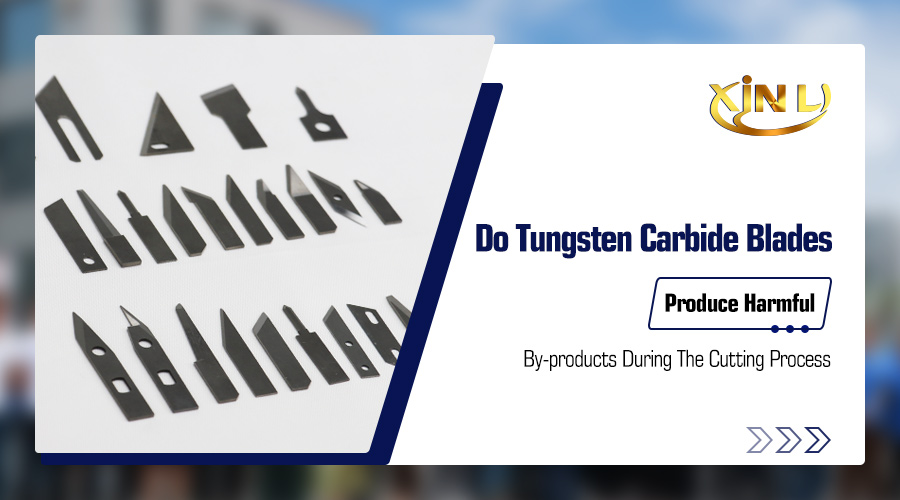In the field of metal processing, tungsten carbide blades are widely used in various cutting operations due to their high hardness, high wear resistance and excellent cutting performance. However, with the acceleration of industrialization and the improvement of environmental awareness, people are more and more concerned about whether tungsten carbide knives produce harmful by-products, such as sparks and smoke, during the cutting process. In this paper, we will discuss this issue in depth and analyze the causes, potential hazards and corresponding countermeasures of the by-products that may be generated during the cutting process of tungsten carbide knives.
1. Spark Phenomenon In The Cutting Process Of Tungsten Carbide Blades
Tungsten carbide blades do have the potential to generate sparks due to friction and impact when rotating at high speeds or cutting hard materials. These sparks, although brief and tiny, can cause safety hazards in specific environments. For example, in flammable and explosive work environments, sparks can be a source of ignition, leading to fires or explosions. In addition, sparks can cause eye and skin damage to operators, especially if proper protective equipment is not worn.
2. Smoke In The Cutting Process Of Tungsten Carbide Blades
During the cutting process of tungsten carbide blades, a large amount of smoke may also be produced. These smokes, which consist mainly of metal particles, cutting fluid (if used) volatiles and possible combustion products, may contain harmful chemicals that can cause irritation and damage to the skin and respiratory system. The smoke also contaminates the processing equipment and the environment. Metal particles and chemicals in the smoke may adhere to equipment surfaces, interfering with proper operation and maintenance of the equipment. Meanwhile, smoke emissions can also pollute the surrounding environment, affecting air quality and ecological balance.
3. Noise And Debris During The Cutting Process Of Tungsten Carbide Blades
In addition to sparks and smoke, tungsten carbide knife cutting process may also produce noise and debris. Noise will not only cause damage to the operator’s hearing, but also may interfere with the quietness of the surrounding environment. Debris may splash outside the work area, causing accidental injury to personnel and equipment.
Countermeasures And Suggestions
In order to reduce the generation of the by-products and their potential hazards during the cutting process of tungsten carbide cutters, the following measures can be taken:
Optimize cutting parameters: By adjusting parameters such as cutting speed, feed and depth of cut, the frictional heat and heat accumulation during the cutting process can be reduced, thus reducing the generation of sparks and smoke.
Use of cutting fluid: cutting fluid can not only reduce the cutting temperature, but also reduce the splash of metal particles and the generation of smoke. Choosing environmentally friendly cutting fluid and reasonably controlling its usage and spraying method can further reduce the harm to the environment and human body.
Enhance ventilation and air exchange: Set up effective ventilation and air exchange system in the working area, which can timely exhaust the fumes and harmful gases outside and keep the air fresh and clean.
Wear personal protective equipment: Operators should wear personal protective equipment such as protective glasses, protective masks and protective clothing to minimize the damage of sparks and fumes to eyes, skin and respiratory system; use noise reduction equipment, such as earplugs or earmuffs, to minimize the damage of noise to the operator’s hearing.
Regular maintenance and inspection: Regularly maintain and inspect cutting equipment and protective gear to ensure their normal operation and effective protection. At the same time, clean up the metal particles and dirt in the working area in time, and keep the working environment neat and hygienic to ensure its normal operation and reduce the generation of debris.
To summarize, tungsten carbide knives may indeed produce harmful by-products during the cutting process, including sparks, smoke, noise, and debris. In order to safeguard the health and safety of operators as well as the normal operation of processing equipment and the environment, effective preventive measures and countermeasures must be taken. By optimizing cutting parameters, using cutting fluids, enhancing ventilation, wearing personal protective equipment, and conducting regular maintenance and inspections, it can effectively reduce the generation of the by-products and their potential hazards.






